Basic Medical Sciences \ 1-1

This book has been prepared with the aim of helping students better understand the Anatomy and Physiology or Human Biology course and to provide a resource for students. While creating the book, care was taken to ensure that the information was short and sufficient. Information about common diseases related to each system is also given. Information in the book; supported by numerous figures, photographs and tables.
This work; It has been prepared at a level that can be useful to students of the Biology Department of the Faculty of Science, Arts and Sciences, as well as to students of other faculties or colleges who take the Anatomy and Physiology course.
This work; It has been prepared at a level that can be useful to students of the Biology Department of the Faculty of Science, Arts and Sciences, as well as to students of other faculties or colleges who take the Anatomy and Physiology course.

A good anesthesia technician/technician should act with correct and high-quality knowledge underlying the practices. In this context, the margin for error of each planned intervention will be negligible. In this book, a wide range of knowledge and practice is expertly presented by anesthesiologists who are experts in their fields, from job description of an anesthesia technician/technician to their responsibilities, from pre-operative considerations to preparation of drugs, from equipment recognition to basic applications.
The content of the book is completely planned in accordance with the curriculum of the anesthesia technician/technician education. In the book, it is aimed to create a more conscious and equipped anesthesia technician/technician identity rather than giving simple information.
Another feature of this book is that important issues and points to be considered in the chapter are carefully presented in boxes.
This book, which will meet the practical expectations in addition to the theoretical information, is the main reference book to be used in the field of anesthesia both during the education period and in the professional life after the education.
The content of the book is completely planned in accordance with the curriculum of the anesthesia technician/technician education. In the book, it is aimed to create a more conscious and equipped anesthesia technician/technician identity rather than giving simple information.
Another feature of this book is that important issues and points to be considered in the chapter are carefully presented in boxes.
This book, which will meet the practical expectations in addition to the theoretical information, is the main reference book to be used in the field of anesthesia both during the education period and in the professional life after the education.

A good anesthesia technician/technician should act with correct and high-quality knowledge underlying the practices. In this context, the margin for error of each planned intervention will be negligible. In this book, a wide range of knowledge and practice is expertly presented by anesthesiologists who are experts in their fields, from job description of an anesthesia technician/technician to their responsibilities, from pre-operative considerations to preparation of drugs, from equipment recognition to basic applications.
The content of the book is completely planned in accordance with the curriculum of the anesthesia technician/technician education. In the book, it is aimed to create a more conscious and equipped anesthesia technician/technician identity rather than giving simple information.
Another feature of this book is that important issues and points to be considered in the chapter are carefully presented in boxes.
This book, which will meet the practical expectations in addition to the theoretical information, is the main reference book to be used in the field of anesthesia both during the education period and in the professional life after the education.
The content of the book is completely planned in accordance with the curriculum of the anesthesia technician/technician education. In the book, it is aimed to create a more conscious and equipped anesthesia technician/technician identity rather than giving simple information.
Another feature of this book is that important issues and points to be considered in the chapter are carefully presented in boxes.
This book, which will meet the practical expectations in addition to the theoretical information, is the main reference book to be used in the field of anesthesia both during the education period and in the professional life after the education.

A good anesthesia technician/technician should act with correct and high-quality knowledge underlying the practices. In this context, the margin for error of each planned intervention will be negligible. In this book, a wide range of knowledge and practice is expertly presented by anesthesiologists who are experts in their fields, from job description of an anesthesia technician/technician to their responsibilities, from pre-operative considerations to preparation of drugs, from equipment recognition to basic applications.
The content of the book is completely planned in accordance with the curriculum of the anesthesia technician/technician education. In the book, it is aimed to create a more conscious and equipped anesthesia technician/technician identity rather than giving simple information.
Another feature of this book is that important issues and points to be considered in the chapter are carefully presented in boxes.
This book, which will meet the practical expectations in addition to the theoretical information, is the main reference book to be used in the field of anesthesia both during the education period and in the professional life after the education.
The content of the book is completely planned in accordance with the curriculum of the anesthesia technician/technician education. In the book, it is aimed to create a more conscious and equipped anesthesia technician/technician identity rather than giving simple information.
Another feature of this book is that important issues and points to be considered in the chapter are carefully presented in boxes.
This book, which will meet the practical expectations in addition to the theoretical information, is the main reference book to be used in the field of anesthesia both during the education period and in the professional life after the education.
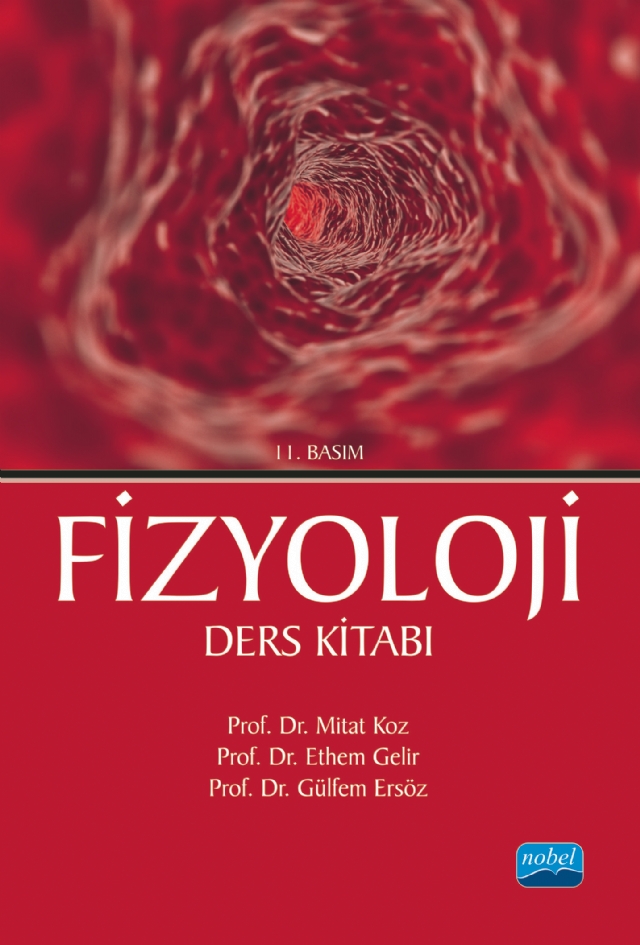
In this book; the organs and organ systems that make up the human body, how the organism functions in its integrity, and how the functional organization of our body takes place are explained in a simple level.
Firstly; in the structural and functional organization part of the human body, it is explained how the basic elements that exist in nature come together to form first chemical compounds, then cells, tissues, organs, systems and finally the whole of the organism and how they work in harmony by completing each other.
In the next parts of the book, cells, which are the functional unit of the organism, respectively; blood, which has basic functions such as transport, protection and regulation; nervous system with functions such as rapid control, coordination and learning-memory between systems; muscular system that elicits movements; the heart and circulatory system, which ensures that blood circulates throughout the body; the respiratory system that provides oxygen, which is the most basic requirement of life; digestive system, which allows energy sources and metabolic building blocks to enter the body; excretory system that allows the wastes formed in the body to be excreted through urine; the sensory system that ensures harmony with our environment through communication; endocrine system, which provides long-term and permanent coordination between systems; the reproductive system that maintains the species; nutrition, metabolism and thermoregulation events are explained separately in each section with the support of some anatomy knowledge.
Firstly; in the structural and functional organization part of the human body, it is explained how the basic elements that exist in nature come together to form first chemical compounds, then cells, tissues, organs, systems and finally the whole of the organism and how they work in harmony by completing each other.
In the next parts of the book, cells, which are the functional unit of the organism, respectively; blood, which has basic functions such as transport, protection and regulation; nervous system with functions such as rapid control, coordination and learning-memory between systems; muscular system that elicits movements; the heart and circulatory system, which ensures that blood circulates throughout the body; the respiratory system that provides oxygen, which is the most basic requirement of life; digestive system, which allows energy sources and metabolic building blocks to enter the body; excretory system that allows the wastes formed in the body to be excreted through urine; the sensory system that ensures harmony with our environment through communication; endocrine system, which provides long-term and permanent coordination between systems; the reproductive system that maintains the species; nutrition, metabolism and thermoregulation events are explained separately in each section with the support of some anatomy knowledge.
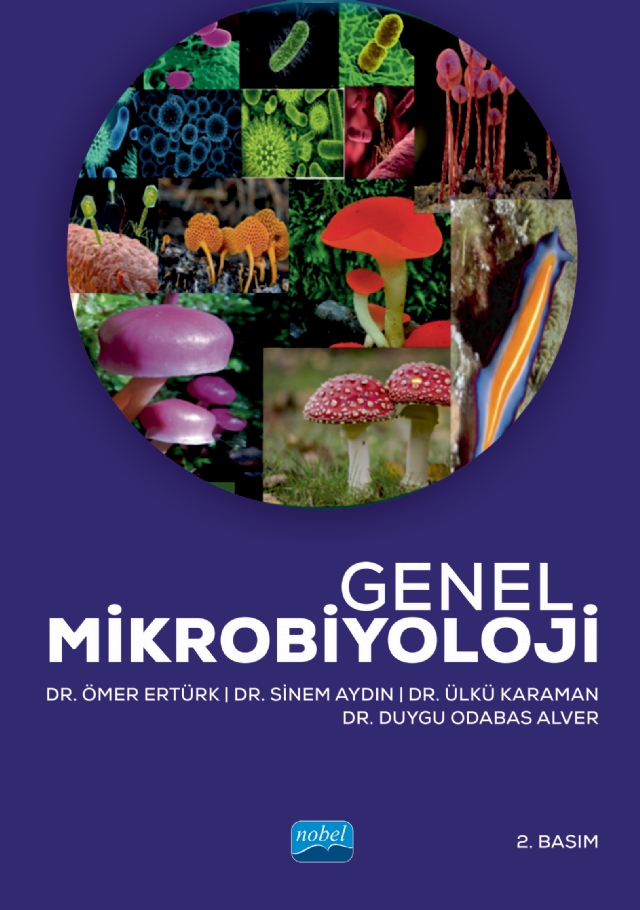
Microbiology has become an important and interesting field for beginners. While learning the content and concepts of basic microbiology, many questions are asked: How do I learn the names of all these microorganisms? What infection does bacteria, virus or fungus cause and which diseases do they cause? How are these diseases treated? In this book, comprehensive information is presented about the information that a student or an academician interested in the field of microbiology is curious about in the field of microbiology. The basic concepts of General and Molecular Microbiology have been tried to be presented in a clear and concise manner that will appeal to students studying in different health fields and academicians interested in microbiology. The topics are written in a plain language, with uncomplicated explanations for difficult concepts. The topics were summarized through tables and figures rather than a long text, and colorful visuals were included for students. In particular, the important points in the reviews were highlighted in the boxes to help the students, and the study questions were prepared to address the relevant aspects of each subject, including clinical cases, and each section was prepared with current developments and information on microbiology. The book starts with a general introduction to microbiology and continues with chapters where general microbiology issues are discussed in detail. All microorganisms are given individually under sections. The sections on bacteria, viruses, fungi and parasites are neatly arranged. Each chapter is presented in color to excite those interested in microbiology and engage them while teaching new information. The book will also be useful in the laboratory applications of the subjects that form the basis of microbiology in the faculties of science, education faculties, medical faculties and dentistry faculties.
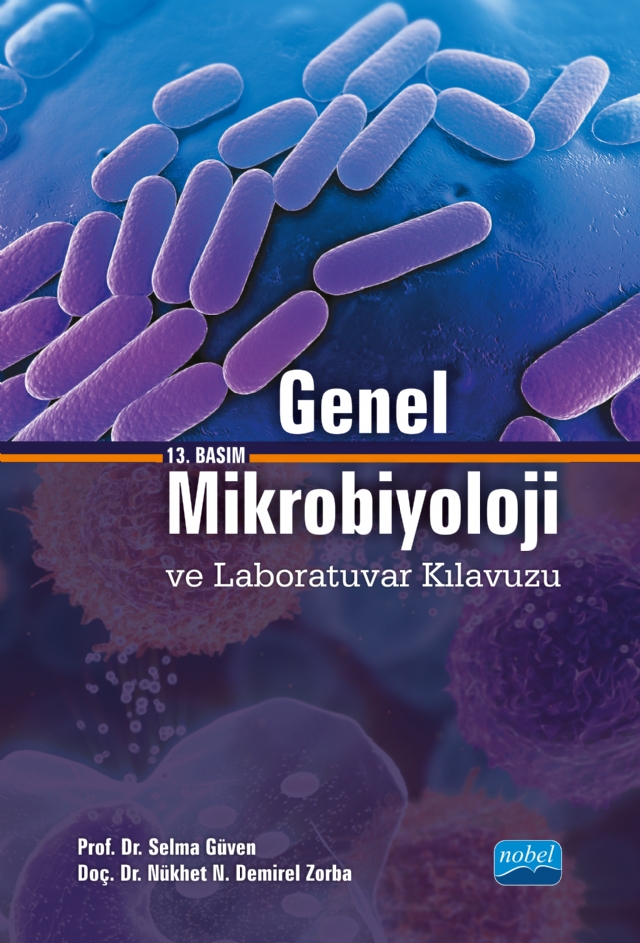
The first edition of our book, of which we have made the 12th edition, was made in 2003 under the title of "General Microbiology". It includes topics such as the morphology, cell structures, development, reproduction, ecology, hereditary changes, classification of microorganisms and consists of 10 chapters. In the 2 (2007), 3 (2011), 4 (2013), 5 (February 2015), 6 (November 2015) editions of the book, tools and equipment used in the microbiology laboratory, aseptic technique, sterilization, microscope types, staining methods, pure culture techniques Laboratory applications such as , media, counting methods are also included. Thus, the book consisting of 24 chapters was named as “General Microbiology and Laboratory Guide”.
In each renewed edition, new sources on the subject were scanned and important information was added. In the 4th edition made in 2013, no significant changes were made in the subject headings except for the additional titles of the structure and functions of nucleic acids (3.2.8.1.) and general and current summary information about antibiotics (5.5.). However, in the 5th edition, the subsection on the structure-functions of nucleic acids (3.2.8.1.) was taken to the 9th section and the name of this section was changed to "genetics of microorganisms and hereditary change". In the 9th edition, additions were made to the 10th chapter. In the 10th and 11th editions, some grammatical errors were corrected and in the last edition the importance of microbiology was added.
Our aim is to present a book on General Microbiology to the students of the Food Engineering Department of the faculties of Engineering and Agriculture and to the students of other departments studying General Microbiology at Universities. Of course, we will be proud that everyone who is interested in the subject will benefit from our book.
We are happy to be able to make the tenth edition of our book, which is popularly read in the relevant departments of both our universities and vocational schools.
In each renewed edition, new sources on the subject were scanned and important information was added. In the 4th edition made in 2013, no significant changes were made in the subject headings except for the additional titles of the structure and functions of nucleic acids (3.2.8.1.) and general and current summary information about antibiotics (5.5.). However, in the 5th edition, the subsection on the structure-functions of nucleic acids (3.2.8.1.) was taken to the 9th section and the name of this section was changed to "genetics of microorganisms and hereditary change". In the 9th edition, additions were made to the 10th chapter. In the 10th and 11th editions, some grammatical errors were corrected and in the last edition the importance of microbiology was added.
Our aim is to present a book on General Microbiology to the students of the Food Engineering Department of the faculties of Engineering and Agriculture and to the students of other departments studying General Microbiology at Universities. Of course, we will be proud that everyone who is interested in the subject will benefit from our book.
We are happy to be able to make the tenth edition of our book, which is popularly read in the relevant departments of both our universities and vocational schools.
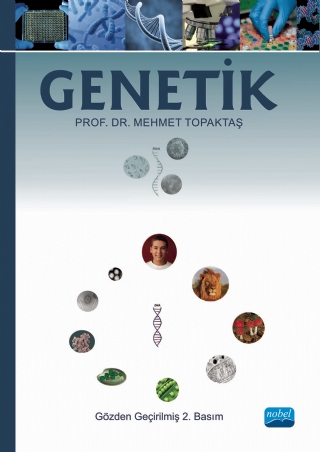
Genetics is the science that studies heredity and heredity in living things. In the science of genetics, besides the classic subjects such as Mendel's Studies, there are also rapidly changing fields, such as in the field of Molecular Genetics. The main thing in a genetics book is to provide the latest information in rapidly changing fields along with classical subjects. In addition, the author should reflect his own views on the book after synthesizing the acquired knowledge. For these reasons, I wanted this book to include not only the topics that I teach my students during limited class hours, but also all the basic topics that should be in a genetics book. That's what I tried to do while writing this book. For this reason, it took many years to write the book, and as a result, this work emerged. I hope that my book will add new richness to the knowledge of the target audience.
Target audience for this book:
• Scientists working in the field of genetics,
• Research assistants working on a postgraduate thesis in the field of genetics and students working on a postgraduate thesis,
• Students of the Biology, Molecular Biology and Genetics Departments of the Faculties of Science and Letters, the Science and Biology Teaching departments of the Faculties of Agriculture, Medicine, Dentistry, Veterinary Faculties, Education Faculties,
• Biology teachers of high schools and science teachers of primary schools and
• People from all walks of life who are interested in genetics.
The fact that the book reaches its goal will make me forget all my tiredness.
Target audience for this book:
• Scientists working in the field of genetics,
• Research assistants working on a postgraduate thesis in the field of genetics and students working on a postgraduate thesis,
• Students of the Biology, Molecular Biology and Genetics Departments of the Faculties of Science and Letters, the Science and Biology Teaching departments of the Faculties of Agriculture, Medicine, Dentistry, Veterinary Faculties, Education Faculties,
• Biology teachers of high schools and science teachers of primary schools and
• People from all walks of life who are interested in genetics.
The fact that the book reaches its goal will make me forget all my tiredness.

The subjects included in molecular biology, cell biology and histology branches have priority in understanding the lessons taken during biology education. Histology, which is the science of tissue, examines the tissues formed as a result of the coming together of similar cells to undertake a certain function, using many different methods.
In this book; First of all, important ways of working for the subject, a brief reminder about the cell, and the formation, classification and briefly functioning of basic tissues such as epithelial tissue, connective tissue, muscle tissue and nervous tissue that cells are structured are discussed. It also focuses on how the basic tissues come together and the organs they form and the emerging systems; Diseases to be associated with each tissue and system are given for general information purposes.
At the end of the book, there is a glossary of words from the book that are not explained in the topic.
In this book; First of all, important ways of working for the subject, a brief reminder about the cell, and the formation, classification and briefly functioning of basic tissues such as epithelial tissue, connective tissue, muscle tissue and nervous tissue that cells are structured are discussed. It also focuses on how the basic tissues come together and the organs they form and the emerging systems; Diseases to be associated with each tissue and system are given for general information purposes.
At the end of the book, there is a glossary of words from the book that are not explained in the topic.

This book, named "Women's Health Practices and Gynecological Problems", is a scientific publication consisting of twenty-five chapters in which women are the main characters. Starting from the basic concepts, the issues that women frequently encounter in their life periods are written in detail and meticulously. The aim of the book, which aims to present a different perspective to current practices and problems with its strong writer staff consisting of various cities and universities in Türkiye, we hope that it will serve as a guide for all researchers who are interested in women's health and will be useful to the scientific world.

With the acceptance of cancer as a genetic disease, scientists continue to research cancer in genetic and molecular terms. Clarifying the molecular mechanisms of cell division and proliferation and learning the molecular pathways in the cell indicate that more research is needed on molecular structures to be targeted in cancer therapy.
We hope that the book "Cancer Genetics and Molecular Biology" will be a useful resource containing up-to-date information that will benefit scientists who will do research in this field and our students studying in departments such as Medicine, Molecular Biology and Genetics, Biology, Biochemistry, Pharmacy and Veterinary.
In the book, cancer epidemiology, carcinogenesis, molecular targets and signaling pathways in cancer, cancer genetics and cytogenetics, genes responsible for cancer, the relationship between cellular aging and cancer, cell death mechanisms and cancer, characteristics of cancer cells, cancer types, angiogenesis, metastasis, immunity, plasticity, topics such as cancer stem cells, biomarkers, ion channels and cancer relationship and multi-drug resistance in cancer are discussed.
We hope that the book "Cancer Genetics and Molecular Biology" will be a useful resource containing up-to-date information that will benefit scientists who will do research in this field and our students studying in departments such as Medicine, Molecular Biology and Genetics, Biology, Biochemistry, Pharmacy and Veterinary.
In the book, cancer epidemiology, carcinogenesis, molecular targets and signaling pathways in cancer, cancer genetics and cytogenetics, genes responsible for cancer, the relationship between cellular aging and cancer, cell death mechanisms and cancer, characteristics of cancer cells, cancer types, angiogenesis, metastasis, immunity, plasticity, topics such as cancer stem cells, biomarkers, ion channels and cancer relationship and multi-drug resistance in cancer are discussed.

In this book, which aims to bring together the secrets of healthy life and related researches of the future in a comprehensive and encyclopedic way, almost all the issues related to the microbiota in the clinic are mentioned. In addition, information on probiotics and the use of probiotics in clinical spectra is presented in their latest updated versions, while different application areas of probiotics and rational nutrition are listed one after the other.
Although the effects of microbiota and probiotics on health and diseases are known, there are still many questions to be answered. Although studies on microbiota have been started in Turkey, infrastructure and standardization problems have not been resolved and there is a need for regulation in many aspects. Because this area has a strategic importance for our country. Although it is changing rapidly, our eating habits are still different from Western countries. Therefore, it is likely that we have a unique intestinal bacterial structure of our own. With the studies to be done on this subject, special diagnosis and treatment methods can be developed for us. The Microbiota, Probiotics and Rational Nutrition book, in which the latest information, experiences and the point reached are discussed by teachers working in different fields of expertise, will also be instrumental in sharing and planning on what can be done in Turkey, who will take part in what way, and how to work.
With the hope and hope that it will be useful to all its readers...
Although the effects of microbiota and probiotics on health and diseases are known, there are still many questions to be answered. Although studies on microbiota have been started in Turkey, infrastructure and standardization problems have not been resolved and there is a need for regulation in many aspects. Because this area has a strategic importance for our country. Although it is changing rapidly, our eating habits are still different from Western countries. Therefore, it is likely that we have a unique intestinal bacterial structure of our own. With the studies to be done on this subject, special diagnosis and treatment methods can be developed for us. The Microbiota, Probiotics and Rational Nutrition book, in which the latest information, experiences and the point reached are discussed by teachers working in different fields of expertise, will also be instrumental in sharing and planning on what can be done in Turkey, who will take part in what way, and how to work.
With the hope and hope that it will be useful to all its readers...

Extraordinary Circumstances (ODD) cause loss of life and property by creating extraordinary results in daily life if preparation is not made. For this reason, it is vital to be prepared for ODDs both before and after. It is imperative to produce solutions with a multidisciplinary approach to developing and dynamic ODDs. For this reason, a systematic approach is important before, during and after ODDs from a Public Health Specialist perspective. The leading ODDs that remain up to date in Türkiye are refugees and migrants who are victims of floods, earthquakes and wars in our country due to our geographical location. In addition to these, many natural and human-induced ODDs such as landslides, transportation accidents and fires are experienced. There is also an absolute need for adequate knowledge for successful intervention in ODDs. Our insufficient level of theoretical knowledge makes things difficult in the already complex disaster area, and even drags the whole operation into chaos.

The Organic Chemistry book, which was mainly prepared to be useful to students in biology-based faculties such as Medicine, Veterinary Medicine, Dentistry and Pharmacy, consists of two parts, Basic and Organic Chemistry. The first chapter starts with the structure of atoms, which are the smallest building blocks that show all the qualities of an element, and covers chemical bonds, acids and bases, important physicochemical principles, and thermodynamics with analytical methods.
In the second part, the basic principles of organic chemistry, also defined as C-Chemistry, isomer, biologically important organic substance groups and reactions specific to these groups, monomers such as amino acids and monosaccharides in the structure of living things, polymers such as proteins, polysaccharides and nucleic acids are important biochemically. molecular structures have been tried to be given briefly and concisely.
It is thought that the book, which tries to emphasize the biological and biochemical importance of the subjects prepared in color so that the changes in the molecular structures during chemical reactions can be seen more clearly and the shapes can be observed more easily, will contribute to the education in the faculties that provide biology-based education and close the gap on this subject.
In the second part, the basic principles of organic chemistry, also defined as C-Chemistry, isomer, biologically important organic substance groups and reactions specific to these groups, monomers such as amino acids and monosaccharides in the structure of living things, polymers such as proteins, polysaccharides and nucleic acids are important biochemically. molecular structures have been tried to be given briefly and concisely.
It is thought that the book, which tries to emphasize the biological and biochemical importance of the subjects prepared in color so that the changes in the molecular structures during chemical reactions can be seen more clearly and the shapes can be observed more easily, will contribute to the education in the faculties that provide biology-based education and close the gap on this subject.
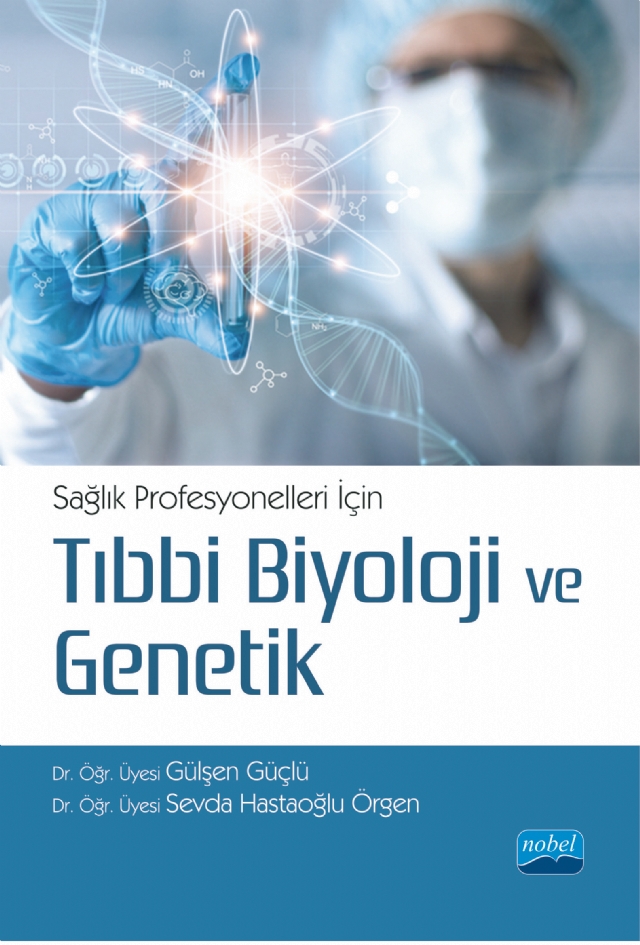
The development of medical biology and genetics with each passing day contributes to the development of new diagnostic and treatment methods in medicine. This book is a versatile book in which basic and up-to-date information is compiled in the field of medical biology and genetics and the acquisition of knowledge in this field is comprehensively covered. It also provides a framework for students to understand the field of medical biology and genetics, while providing the basis for establishing a continuing education program in this field.
Medical Biology and Genetics for Health Professionals book; I hope it will be a resource for everyone interested in medicine and biology education and will motivate them to take a stronger step towards science and new ideas...
Medical Biology and Genetics for Health Professionals book; I hope it will be a resource for everyone interested in medicine and biology education and will motivate them to take a stronger step towards science and new ideas...

This book; specially prepared for scientific research. The examples related to the subjects were solved first theoretically and then with SPSS, AMOS and META package program. A researcher who wants to do statistical analysis; will be able to analyze and interpret the results by looking only at the subject of interest without examining the entire book.
The book has been prepared by taking into account the contents of SPSS, AMOS and META package programs, which are frequently used in scientific research. In addition, MINITAP package program was used for power analysis.
In the classification of analysis techniques; The number of variables, data characteristics and the purpose of the analysis were taken into account. Almost all univariate and multivariate statistical analysis methods are explained. Almost all of the parametric and non-parametric statistical analysis methods are explained. In addition, association measures, reliability and item analysis, structural equation modeling were examined in detail.
Although this book has been prepared especially for scientific research, it can also be used for undergraduate and graduate education since it also contains theoretical information.
The book has been prepared by taking into account the contents of SPSS, AMOS and META package programs, which are frequently used in scientific research. In addition, MINITAP package program was used for power analysis.
In the classification of analysis techniques; The number of variables, data characteristics and the purpose of the analysis were taken into account. Almost all univariate and multivariate statistical analysis methods are explained. Almost all of the parametric and non-parametric statistical analysis methods are explained. In addition, association measures, reliability and item analysis, structural equation modeling were examined in detail.
Although this book has been prepared especially for scientific research, it can also be used for undergraduate and graduate education since it also contains theoretical information.
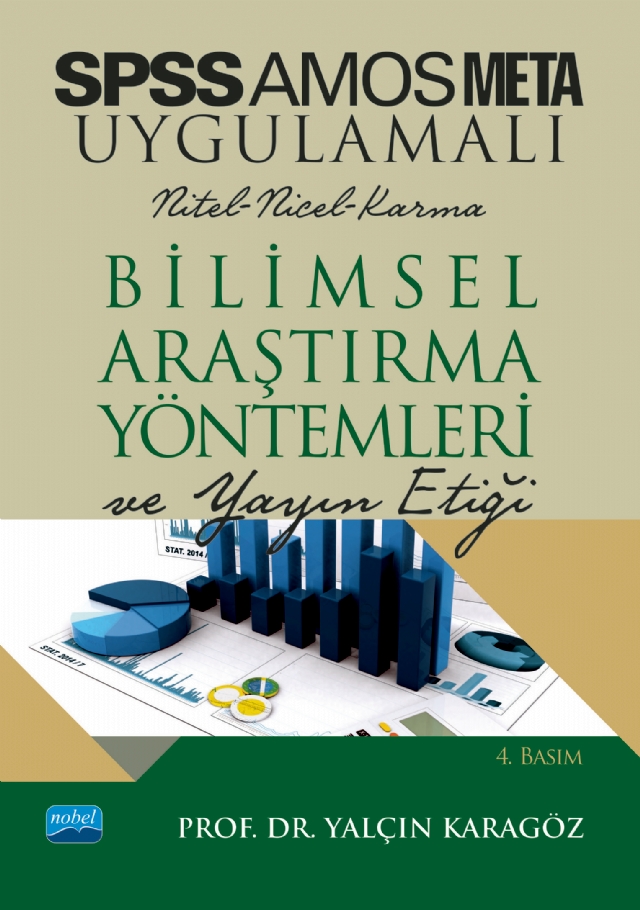
This book has been prepared for undergraduate, graduate and especially scientific research. In this book, in quantitative, qualitative and mixed research, how the research process (determining the research problem, establishing hypotheses, determining the sampling method, data collection, reliability, validity, analysis of the data, evaluation of the findings, reporting, publication ethics etc.) will be carried out, quantitative, qualitative and mixed research. terms of use of analysis methods, use of package programs (SPSS-AMOS-META) in the analysis of data, statistics specific to the field of health, etc. tried to be given. In quantitative methods, parametric and nonparametric techniques and their differences, analysis methods to be applied according to these differences are given. Similarly, the differences between qualitative methods and the situations to be applied according to these differences are given.

This book has been prepared for faculty or college students who take the biochemistry course in a short period of time, such as one semester. Although there are many translated and written biochemistry books in our country, what makes this book unique among them is that it has a content and appropriate volume that students can easily understand.
In the writing of the book, one of the most valid methods in learning and teaching, the "general to detailed method" was applied. At the beginning of each topic, a brief summary of that topic is given and then the details of the topic are given.
In order to better understand the information, the written information is associated with examples and analogies and supported by many formulas, pictures and tables.
In the writing of the book, one of the most valid methods in learning and teaching, the "general to detailed method" was applied. At the beginning of each topic, a brief summary of that topic is given and then the details of the topic are given.
In order to better understand the information, the written information is associated with examples and analogies and supported by many formulas, pictures and tables.

Click to download PDF file
Medical biology and genetics is the science of biology that studies the hereditary character that affects human existence and health. This book has been arranged according to the needs of the departments to be used during the conduct of the "Medical Biology and Genetics" course taught in the first years of Health Services programs and faculties. The selected course contents are handled in a general framework and aim to provide students with a basic perspective on the field. The chapters of the book are planned as seven chapters in accordance with this purpose. In the first three chapters, cell biology and metabolism are explained from simple to complex in the light of current literature. In the following three chapters, the structure and organization of hereditary material are explained and detailed information is given about genetic diseases affecting human health. In the last section, cancer genetics and pathogenesis are explained and the pathophysiological process from gene to cell behavior is discussed as a whole.
Students who are new to higher education have difficulty in understanding the main subjects of medical biology and genetics, which consist of abstract data. For this reason, the topics in the book are explained in an understandable language as well as being embodied with detailed drawings. Although the topics are explained briefly and concisely, they are supported by the current literature.
Medical biology and genetics is the science of biology that studies the hereditary character that affects human existence and health. This book has been arranged according to the needs of the departments to be used during the conduct of the "Medical Biology and Genetics" course taught in the first years of Health Services programs and faculties. The selected course contents are handled in a general framework and aim to provide students with a basic perspective on the field. The chapters of the book are planned as seven chapters in accordance with this purpose. In the first three chapters, cell biology and metabolism are explained from simple to complex in the light of current literature. In the following three chapters, the structure and organization of hereditary material are explained and detailed information is given about genetic diseases affecting human health. In the last section, cancer genetics and pathogenesis are explained and the pathophysiological process from gene to cell behavior is discussed as a whole.
Students who are new to higher education have difficulty in understanding the main subjects of medical biology and genetics, which consist of abstract data. For this reason, the topics in the book are explained in an understandable language as well as being embodied with detailed drawings. Although the topics are explained briefly and concisely, they are supported by the current literature.

In recent years, our knowledge has increased within the scope of research on the molecular basis of diseases. With the use of increasing knowledge in both medical biology and medical genetics, diseases caused by cellular and chromosomal changes, which have a genetic basis, are tried to be understood on the one hand and treated on the other. Written from this point of view, this book covers all topics from the beginning of life to cell death mechanisms under the main title of "Medical Biology". Under the main title of “Genetics”, it provides an integrity starting from the structure of DNA and RNA, including the features of the genetic code, mutations and inheritance patterns. The difference of our book from its counterparts written so far is that the second part includes molecular genetics applications and practical applications step by step. There are six chapters in the "Application" part of the book, in which medical biology and genetics are covered in fourteen chapters. This book, which has been prepared in accordance with the curriculum of the relevant boards of medical faculties, is a textbook that can be used in the relevant departments of health sciences faculties, dentistry faculties and health schools. This book, which has been prepared as a result of intense effort by following up-to-date data in a period of about two years, is a resource that undergraduate, graduate students and all academics can benefit from.

Medical (clinical) laboratory management has a key position in the healthcare sector in terms of human health, patient safety, quality of community/population life and cost effective healthcare expenditures. Medical/Clinical laboratories (MLs/CLs) are also the data centers of healthcare institutions. Laboratory tests are requested from approximately 80% of individuals admitted to a health institution, and 70-80% of medical decisions are made based on the test results. In addition to providing reliable test results to each individual/patient in a timely and cost-effective manner, information about public health status can also be obtained from laboratory data.
Their success in these responsibilities and duties is directly proportional to their ability to
establish a well-structured risk, quality and process-based system.
In this book: a risk, quality and process-based management model is presented. The book covers the steps of recognizing and introducing the process framework of a medical (clinical) laboratory that is composed of the management and support processes. The total examination process, which is the main core process of an ML/CL, is composed of 5 subprocesses. The steps also include the application of risk and quality management to every process. By following this book, the laboratory professional will be able to define and introduce all the processes of a ML/CL and establish the management system with the process approach. Laboratory professionals will be able to familiarize themselves with each process and create process-oriented risk and quality management systems following the recommended steps. A continuous process improvement system, based on the Plan-Do-Check-Act (PDCA) Cycle, will also be established. Hence, the ML/CL will be prepared to meet all the requirements of external assessment programs, including the ISO 9001:2015 Quality Management System Standard, the excellence models such as the EFQM, and the Accreditation Standard ISO 15189:2022 for Medical Laboratories-Requirements for Quality and Competence.". The book is designed to be used as a handbook and consists of 22 chapters. The reader will be able to define the process framework of a medical laboratory and identify its documents according to the document hierarchy. Additionally, they can structure the total testing process, which includes preanalytical, analytical, and postanalytical processes both inside and outside the laboratory. Furthermore, the book covers topics on management and support processes as well as data analysis, the development of training programs for laboratory professionals and providing the useful information to the patients. Moreover, the book reviews the governance system, the
alignment of process objectives with strategic goals, outcomes of performed projects related to the medical laboratory management, and the essential competencies for a medical laboratory manager.
This book should be read with the book “Process-Based Management Are You Ready for Digital Transformation? (For Public, Private and Non-Governmental Organizations) by Diler Aslan”
Their success in these responsibilities and duties is directly proportional to their ability to
establish a well-structured risk, quality and process-based system.
In this book: a risk, quality and process-based management model is presented. The book covers the steps of recognizing and introducing the process framework of a medical (clinical) laboratory that is composed of the management and support processes. The total examination process, which is the main core process of an ML/CL, is composed of 5 subprocesses. The steps also include the application of risk and quality management to every process. By following this book, the laboratory professional will be able to define and introduce all the processes of a ML/CL and establish the management system with the process approach. Laboratory professionals will be able to familiarize themselves with each process and create process-oriented risk and quality management systems following the recommended steps. A continuous process improvement system, based on the Plan-Do-Check-Act (PDCA) Cycle, will also be established. Hence, the ML/CL will be prepared to meet all the requirements of external assessment programs, including the ISO 9001:2015 Quality Management System Standard, the excellence models such as the EFQM, and the Accreditation Standard ISO 15189:2022 for Medical Laboratories-Requirements for Quality and Competence.". The book is designed to be used as a handbook and consists of 22 chapters. The reader will be able to define the process framework of a medical laboratory and identify its documents according to the document hierarchy. Additionally, they can structure the total testing process, which includes preanalytical, analytical, and postanalytical processes both inside and outside the laboratory. Furthermore, the book covers topics on management and support processes as well as data analysis, the development of training programs for laboratory professionals and providing the useful information to the patients. Moreover, the book reviews the governance system, the
alignment of process objectives with strategic goals, outcomes of performed projects related to the medical laboratory management, and the essential competencies for a medical laboratory manager.
This book should be read with the book “Process-Based Management Are You Ready for Digital Transformation? (For Public, Private and Non-Governmental Organizations) by Diler Aslan”

The fact that the epidemic that occurred anywhere in the globalizing world was on the agenda of other countries in a short time has made medical microbiology more important as well as many disciplines. In this sense, microbiology education with its theoretical and practical applications has become even more important and necessary in training professional technical personnel for the field. The book is planned as a laboratory guide that provides up-to-date practical information without going into any detail to Health Services Vocational Schools Medical Laboratory Technician students and educators, medical school students, medical microbiology graduate-doctorate and medical specialty students, and moreover, to everyone related to medical microbiology.
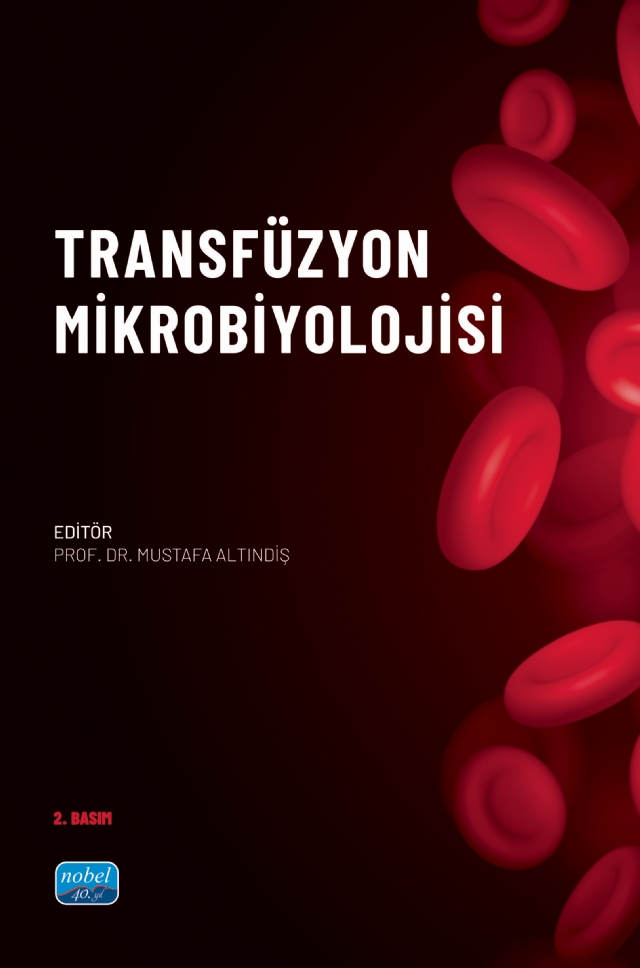
The field of transfusion microbiology is of particular importance since the use of blood, which is still the only source of human blood, as a life-saving medical product when necessary, concerns all parties and processes in terms of patient safety.
Microbiology has always been intertwined with transfusion medicine from the very beginning. With our current knowledge, viral hepatitis and later HIV have been observed as inevitable and persistent complications of transfusions long after the onset and development of transfusion. For more than four decades, blood centers have struggled with the control of these and other transfusion-transmitted microorganisms. In the years before the routine screening of hepatitis (especially hepatitis C), blood transfusions were accepted as the main mode of transmission of these agents. Subsequent HIV transmission could also be a major transfusion tragedy.
All these have taught us that the process must be managed with serious actions in ensuring blood transfusion safety. Today, even more unpredictable factors have emerged, and it seems that they will continue to emerge and besiege humanity.
Microbiology has always been intertwined with transfusion medicine from the very beginning. With our current knowledge, viral hepatitis and later HIV have been observed as inevitable and persistent complications of transfusions long after the onset and development of transfusion. For more than four decades, blood centers have struggled with the control of these and other transfusion-transmitted microorganisms. In the years before the routine screening of hepatitis (especially hepatitis C), blood transfusions were accepted as the main mode of transmission of these agents. Subsequent HIV transmission could also be a major transfusion tragedy.
All these have taught us that the process must be managed with serious actions in ensuring blood transfusion safety. Today, even more unpredictable factors have emerged, and it seems that they will continue to emerge and besiege humanity.

One of the most important elements of healthy generations, societies and a healthy future is reproductive health. Our book, which deals with reproductive health problems, tries to show the current situation in reproductive health, sexual health and family planning in the world and in Türkiye by providing comprehensive information to health professionals in dealing with these problems. In addition, the changing society structure and reproductive health have been evaluated in a wide perspective, and we think that it can be an educational, refreshing and inspirational source for health professionals and candidates in determining the sexual health, reproductive health and family planning needs of men, children and risky groups, especially women.
